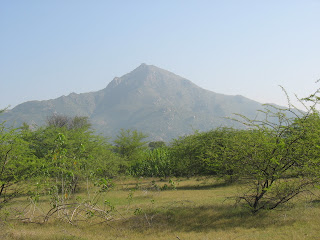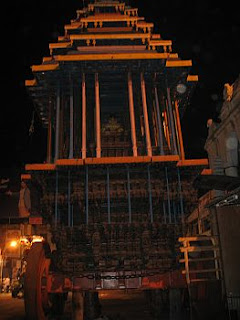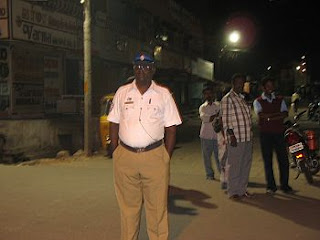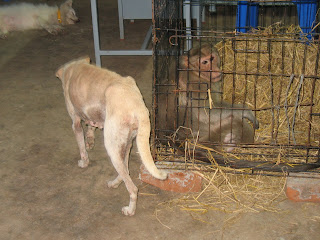One of the earliest references to Karthigai Deepam festival is found in the Ahananuru, a book of poems, which dates back to the Sangam Age (200 B.C. to 300 A.D.). The Ahananuru clearly states that Karthigai is celebrated on the full moon day (pournami) of the Tamil month of Karthigai. It was one of the most important festivals (peruvizha) of the ancient.
Karthigai is essentially a festival of lamps. The lighted lamp is considered an auspicious symbol. It is believed to ward off evil forces and usher in prosperity and joy and indispensavle for the festival of Karthigai.
After the completion of the preliminary 3 day functions; Sri Durgambal on Kamadenu vahanam, Sri Pidariamman on Lion vahanam, Sri Vinayagar on Mooshiga vahanam, the ten days of Bhrammotsavam which takes place in the month of Kartikai (Scorpio, Nov 15 through December 15), started up today.
Each of these festival days is marked by a procession of the Pancha Murthis (5 God idols) inside the Big Temple and around the streets of Tiruvannamalai. The Gods are; Arunachaleswarar (Shiva), Unnamulaiyaal (Shakti, Parvati), Ganapati, Subramanian (Murugan) and Chandikeswarar in gaily decorated mounts.
Most noteworthy among the proceesions are the Rishabha Vahana Utsavam celebrated on the fifth evening (19th November) of the festival and the Rathotsavam (Maha Radham) Big Wooden Chariot around roads of town, celebrated on the seventh day of the festival (November 21st).
Order of Processions
First Day 15th November
Day: Panchamoorthies
Five Deities Silver Chariot
Night: Panchamoorthies
Mooshigan Mayil (Peacock), Adihara Nandi (Bull),
Sina Rishaba Chariots
********************
Second Day, 16th November
Day: Sri Vinayagar
Sri ChandrasekaraVimanams
(Chariots) of Sooriya Prabha; the Sun.
Night: Panchamoorthies
Silver Indra Vimanam Chariots
********************
Third Day, 17th November
Day: Sri Vinayagar
Sri Chandrasekara in new Vahanams
Night: Panchamoorthies
Simha (Lion) Vaahanamam,
Silver Swan etc
********************
Fourth Day, 18th November
Day: 1008 Sanka Abishekam,Sri Vinayagar,
Sri Chandrasekara Vimanams - Naga (Cobra) Vahanam
Night: Panchamoorthies
Silver Kalpatraru, Kamadenu (Cow of Plenty),
Ruby and Silver Chariots.
********************
Fifth Day, 19th November
Day: Sri Vinayagar
Sri Chandraskara Glass, Rishaba Vahanams, Silver Elephant
MAJOR PROCESSION Night: Panchamoorthies
Silver Mooshigan,Silver Mayil
Large Silver Bull Rishaba Vahanam
********************
Sixth Day, 20th November
Day: Sixty-Three Nayanmars (Saints)
Sri Vinayagar, Sri Chandraskara Mooshikan
Night: Panchamoorthies
Indra Vimanam - Silver Car, Etc.
********************
Seventh Day, 21st November
BIGGEST AND GRANDEST PROCESSION
Big Wooden Chariot -
The Maha Radham around roads of town
Night: Panchamoorthies reach Ashthana Mandapam
********************
Eighth Day, 22nd November
Day: Sri Vinayagar,Sri Chandrasekara, Silver Chariot
Night: Panchamoorthies start with Horse
Vahanams etc at night 4.p.m. Pichandavar in Golden Meru
********************
Ninth Day, 23rd November
Day: Sri Vinayagar,Sri Chandrasekara, Glass Vimanam
Night: Panchamoorthies
Kailasa Vahanam,
Kamadenu - Cow of plenty
Raveneswaram Vahanam etc.
********************
Tenth Day, 24th November
MAHADEEPAM DAY
4 a.m. Maha Barani
Day: Tank Teertham
Ceremony 4.00 A.M.
Dusk: Panchamoorthies in Golden Vimanams
6 p.m. Deepam fire on top of Mountain.
Tank Ceremony
********************
Tank Ceremony
25th November
Day: Sri Chandrasekara Boating Festival
Night: Panchamoorthies in Golden Rishaba Vimanams.
********************
Tank Ceremony
26th November
Day: Sri Parasakthi Boating Festival
Night: 7 p.m Sri Arunachaleswara
and Mother Apeethakuchalambal
Sri Chandikeswarar
********************
Tank Ceremony
27th November
Day: Sri Subramania Boating Festival
********************
Tank Ceremony
28th November
Day: Sri Chandikeswarar Festival
Night: Sri Chandikeswarar Utsavam
Rishaba Vahanam
Silver Bull.


 Dig away - please!
Dig away - please!




















































